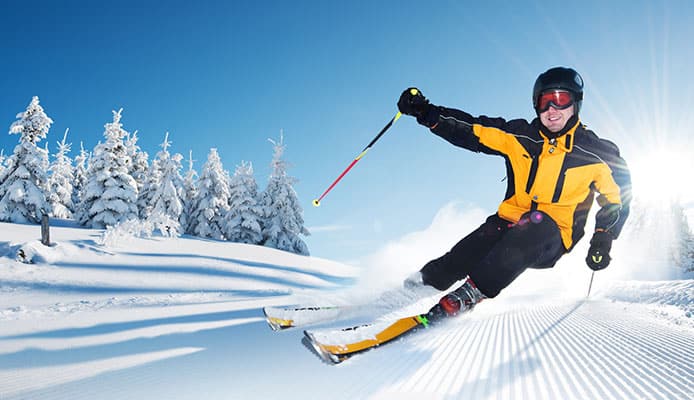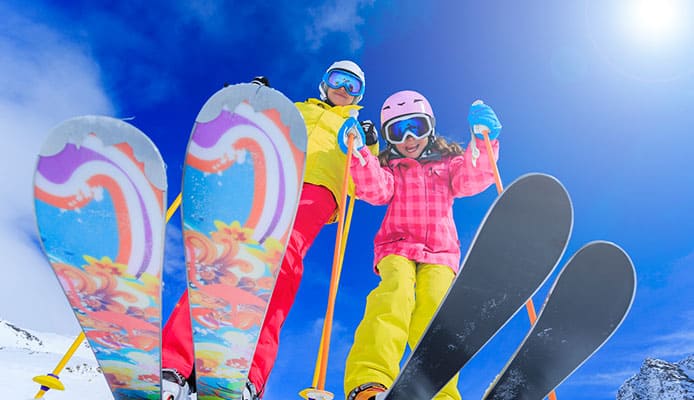
Are you having trouble choosing between camber and rocker profiles for your skis or snowboard? Well, if you are just getting started with skiing or snowboarding, this can be a tricky task because both designs will affect the way you glide.
Camber or rocker describes how a ski or snowboard is curved when observed from the side. In this post, we are going to compare camber vs rocker profiles to help you choose the right one for your skiing and snowboarding equipment. Let’s get started!
Design
Camber
Cambered skis and boards are “springy”, which gives users good edge control when carving turns. When not in use, the midsection (waist) appears uplifted while the tip and tail (contact points) sit on the ground.
The camber is the point where the equipment arcs upward. When the skier or snowboarder applies weight on his skis or board, this area flattens, forming a continuous edge contact with the ice. A cambered ski or snowboard will provide control and precision at high speeds, a firm grip on hard snow, and stability when turning.
Other cambered designs are just flat between contact points, commonly known as flat cambers. These styles provide a more stable glide without being too aggressive, which means they could great for new skiers and snowboarders. The only downside is that they are prone to catching an edge. And since they have too much contact with the snow surface, they are much slower than the traditional camber.
So if you are looking for speed, a flat camber may not be the best option. In fact, this style is not so common today. A flat to rocker profile, on the other hand, is a great choice for beginner skis and snowboards.
Rocker
If you own one of these vintage rocking chairs, then it shouldn’t be hard for you to understand how a rockered ski or snowboard looks like. A rocker design is characterized by a balanced, continuous curve that arcs up from the middle of the board or ski, just like the rails of a rocking chair.
Unlike camber, the point of contact with the snow is close to the feet of the rider and directly below him. This design is also known as alternate camber, negative camber, or reverse camber because it is technically the opposite of camber.
Rocker provides snowboards and skiers with improved floatation on soft snow, greater maneuverability because of the minimized edge contact with the ice, and improved park experience.
Terrain
Another factor to consider when comparing rocker vs camber is the terrain on which you will be skiing or gliding as well as your level of experience. Whether you are looking to buy an expert, intermediate, or beginner snowboard or ski equipment, where you will be riding will help you land the best amount of rocker or camber. Below is a quick camber vs rocker comparison based on different terrains:
Groomed Terrain
Skis and snowboards with a cambered design are popular here because they are fast, more stable, and provide reliable edge control. Rockered snowboards and skis will also do well in this terrain but will cause drag when conditions get icier.
To provide the best of both worlds, ski and board manufacturers have invented camber-rocker hybrids that make gliding through rough and chopped up trail a little easier,
All Mountain
If you will be visiting both groomed and ungroomed trails, a rockered all-mountain snowboard or skis would be your best bet. These turn quickly and easily and provide extra float in powder.
Boards that combine rocker and camber are also popular in various conditions. For instance, a rockered tip will provide good floatation and easier turning while sliding off-piste and a cambered midsection will provide good edge control.
Powdered Ice
The fully rockered snowboards and skis were originally built to ride on the powder. Due to their early rising tips and tails that float on the soft ice, it is less likely that they will catch an edge.
In a rockered ski or snowboard, you are more centered over your ski or snowboard bindings, which helps in reducing back leg burn when riding in deep ice. Cambered boards can glide in powder as well but using a setback stance. Boards and skis with camber and rocker features can be used here too.
Pipe/Park
Cambered boards and skis are more stable, which makes them a preferred option for snowboarders and skiers when executing jumps in groomed trails and parks. They provide more controlled pop off jumps.
Boards with a rockered profile, however, make transitioning from tip to tail easier. For jibbing, rockered snowboards ad skis help to prevent hang-ups on rails and boxes. Pressing into rails is usually much easier with rockered boards than with a camber.
Experience Level

Your skill level can also help you collate rocker vs camber. For example, skiers and snowboarders of all skill levels will benefit from the rockered design. Yet those who are new to snowboarding or skiing or haven’t been out in the snow for years will enjoy an almost instant boost from a board or ski that features a bit of rocker.
A rocker-camber hybrid will work well for advanced riders. With different features that address rider needs, these snow hobbyists can fine-tune their glide by investing in a hybrid that best matches their needs.
You might also like: Perfect Ski Poles
Camber-Rocker Hybrid
Camber-rocker profiles combine the features of both the camber and rocker designs with the intent of providing an all-round board. Looking from the side, a hybrid board will appear to have a wavy edge.
Depending on the brand, the camber can be underneath the bindings to allow for looser turns without compromising on pop, or in the center to enable proper curving. The rocker usually extends towards the tip and tail to enhance stability.
The most common hybrids today are hybrid camber (rocker/camber/rocker) or hybrid rocker (camber/rocker/camber). When the rocker is at the tip and tail, it provides improved turning and floating in powder ice. The camber underfoot increases stability, speed, pop, and edge-hold.
How pronounced the camber and rocker are as well as the length of the rocker and camber sections vary from manufacturer to manufacturer and these variations provide riders with different experiences. Snowboards and skis with precise camber sections or longer rocker sections will be good for beginners.
The camber will provide stability and the rocker section will make turning easy. Combo rocker profiles where the camber sections are highly pronounced are not suitable for new riders.
Even though combos give you a taste of both designs, they obviously don’t provide the same high-quality performance as full rocker or camber profiles.
Globo Surf Overview
Understanding the differences between camber and rocker profiles enables you to choose skis or boards that meet your specific needs. Cambered designs will provide precision at high speed, stability when turning, and a good “bite” of the snow. Rockers, on the other hand, will offer improved floatation in soft ice, greater maneuverability, and reduced risk of catching edges. And depending on your experience level, you may even want to give a hybrid a shot to enjoy the perks of both!
More Snow Ski Gear Guides:
- DIN Calculator: Guide On How To Calculate DIN Setting For Ski Bindings
- How To Remove Ski Bindings
- Do You Really Need Ski Goggles
- Ski vs Snowboard Clothing Guide
- How To Layer For Skiing
- How To Choose Ski and Snowboard Goggles
- How To Size Ski Poles

